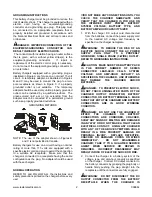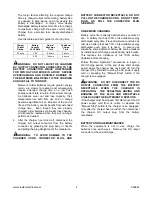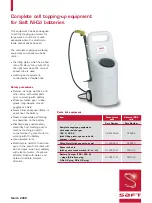
www.lesterelectrical.com
3
00988J
OPERATING. THE RESULTING ARCING AND
BURNING OF THE PLUG AND RECEPTACLE
COULD CAUSE THE BATTERIES TO EXPLODE. IF
THE CHARGER MUST BE STOPPED, FIRST
DISCONNECT THE AC POWER SUPPLY CORD
FROM ITS OUTLET, THEN DISCONNECT THE
CHARGER DC OUTPUT PLUG FROM THE
BATTERY RECEPTACLE.
Three to five (3-5) seconds after the charger and
battery connectors are engaged, the control relay
inside the charger will click "closed", indicating a
complete electrical circuit between the controller
kit inside the charger and the equipment battery
pack.
After the relay clicks "closed", the transformer will
hum indicating that the transformer has been
energized by AC power.
After the transformer hums, the ammeter needle
will deflect indicating initial charge rate.
3.
MONITOR THE AMMETER FOR THE INITIAL
CHARGE RATE
The correct initial charge rate will vary due to
numerous factors, it should be approximately 25
amperes.
INITIAL CHARGE RATE
Charger Current
Rating
Minimum
(-18%)
Rating
Maximum
(+18%)
25
18
25
29.5
If the ammeter reads 30 amperes after 30
minutes, turn the charger off by first disconnecting
the AC plug from its receptacle.
CAUTION: TO PREVENT OVERHEATING AND
TRANSFORMER DAMAGE TO THE CHARGER, DO
NOT ALLOW THE CHARGER TO OPERATE FOR
MORE THAN 30 MINUTES WITH AMMETER
READING 30 AMPERES.
This high charge rate is caused if the charger is
connected to a battery pack with a system voltage
lower than specified on the charger. If battery
maintenance has recently been performed, check
to see if an individual battery has been connected
reverse polarity. Test by measuring the battery
system voltage with an accurate voltmeter at the
equipment battery connector.
If the batteries have been recently charged, the
battery is cold (temperature below 65
°
F) or the AC
input voltage is lower than nominal the initial
charge rate may only reach the minimum initial
charge rate at turn on for the specific current
rating charger.
If the initial charge rate is less than half of the
specified minimum initial charge rate at the
moment of turn on, the charger may be
malfunctioning due to electrical overload damage.
Turn the charger off by first disconnecting the AC
plug from its receptacle.
CAUTION: DO NOT USE THE CHARGER IF
THE OUTPUT IS LOW. BATTERIES WILL NOT
REACH FULL CHARGE, THEREBY INCREASING
THE POSSIBILITY OF A HARMFUL DEEP
DISCHARGE DURING THEIR NEXT USE.
This too low a charge rate at the instant of turn-on
can be due to a charger malfunction resulting from
electrical overload damage, or the battery pack
system voltage is higher than specified on the
charger. Test for the correct battery pack system
voltage with an accurate voltmeter at the
equipment battery connector. Check the fuse
assembly or individual fuses for an indication of
charger electrical overload damage. A blown
single fuse or single fuse link of the fuse assembly
indicates an electrical overload damage caused
short circuit failure of a rectifier diode.
DO NOT DISASSEMBLE THE CHARGER. Take
the charger to a qualified service agent to have
the heatsink assembly with diodes and correct
replacement fuse or fuse assembly installed.
Incorrect reassembly may result in a risk of
electric shock or fire.
During charge, the battery voltage gradually
increases which causes the charge rate to
decrease. Batteries able to deliver their full rated
capacity will still rise to 2.5 volts per cell, or higher,
at 80
°
F, as they reach maximum charge. This will
allow the charge current to decrease or taper to
the chargers designed finish charge rate or lower
at the end of charge. Refer to chart.
Charger
Current
Rating
Finish Current
@2.5 Volts/Cell
@80
°
F
Normal Finish
Charge Current
Range
25 amps
8 amps
10 amps or less
Since each battery cell accepts charge at a
slightly different rate, charging with the ammeter
reading in the normal finish charge range for the
last few hours of charge is important to achieve
equalization of all battery cells every time the
batteries are charged.
As batteries wear out and lose capacity, the end
of charge finish voltage continually decreases. As
the end of charge finish voltage decreases to less
than 2.5 volts per cell, this prevents the finish
charge current from decreasing to the normal
finish charge current range. The controller kit still
determines when the batteries have reached their
now reduced maximum charge capacity and will
turn the charger off.
























